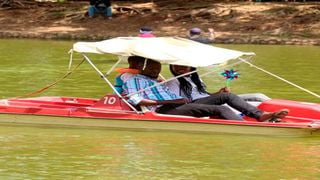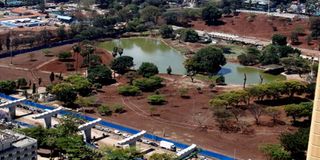
The artificial lake will be transformed into a major waterfront with a Swahili restaurant just alongside it.
| Lucy Wanjiru | Nation Media GroupNairobi
Premium
Badi's dream for new-look Uhuru Park
Uhuru and Central parks lie side by side just like the famous Kameno and Makuyu ridges in Ngugi wa Thiong’o’s novel The River Between. And between them is a valley –Valley Road.
But unlike Kameno and Makuyu ridges, the two public parks have existed in harmony for more than four decades now even though the former has been grabbing the limelight.
The two iconic parks used to be peaceful recreational facilities in the city where people could sit and relax without disturbance.
Uhuru Park hosts an artificial lake (located in the centre of the park), several national monuments, and an assembly ground that had become a popular skateboarding spot on weekends.
Uhuru Park, the more famous of the two, offered a safe haven for lovebirds and families to enjoy the lush green grass and other amenities.
Several benches and beautiful monuments dotted the park; Lunar Park nearby offered a place for children, complete with a merry-go-round, toy cars, trains, an inflatable mobile swimming pool, boat riding and bamboo shades to hide from the scorching sun.
But after years of neglect, the public parks turned into open-air markets crammed with hawkers, small scale traders and street families. In the process, they slowly lost their allure.
Political rallies soon took centre stage at the park with street families also ruthlessly running roughshod over anyone who dared cross their paths.
But with the Nairobi Metropolitan Services (NMS) taking over four Nairobi County government functions including county health services –transport services, public works, utilities and ancillary services and county planning and development last year March-, the parks were earmarked for rehabilitation.
In July this year, NMS Director General Lieutenant General Mohamed Badi announced plans to transform Uhuru and Central parks to the standards of the parks in Dubai, United Arabs Emirates.
This development is part of an ambitious project of restoring and transforming the Nairobi River ecosystem as well as green and public spaces in the capital aimed at revitalising major neighbourhoods in the capital.

Apart from the artificial lake, Uhuru Park is home to several national monuments, such as the iconic Nyayo statue and Mau Mau freedom fighters memorial, and an assembly ground that was a popular skateboarding spot on weekends and a location for local skateboarding competitions.
Lt Gen Badi explained that the plan was to see the two parks mirror those in Dubai by making them more engaging to visitors.
The transformation, he said, would touch on landscapes, playgrounds, and the architecture of built structures to create compelling spaces that attract more visitors to the parks.
“We intend to change Uhuru and Central parks into modern garden with flowers and waterfronts just like the ones in Dubai,” said Mr Badi.
And in September, the Nairobi County Assembly approved a Motion by Majority Leader Abdi Guyo giving NMS the green light to close the two parks and commence renovations.
Mr Guyo said the iconic parks have suffered years of neglect and are in a state of disrepair, and risk of losing their appeal, historical significance and recognition should their deteriorating situation not be remedied as a matter of urgency.
Bulldozers storming the two facilities
He explained that rehabilitation and retrofitting of urban parks and green spaces in Nairobi County was part of the presidential legacy projects and therefore needed the full support of the county.
A month later, the two public parks were fenced off with bulldozers storming the two facilities to commence the transformational journey.
If all goes to plan, the two parks will boast state-of-the-art modern facilities and amenities lifting the once deplorable recreational sites into modern green areas.
According to a master plan by NMS, the new look Uhuru Park will comprise a modern garden with waterfronts.
The 12.9-hectare park will boast manicured lawns, maintained trees, enhanced walkways and green spaces.
The lilies pond at the park will be turned into an aquarium to be known as Uhuru Aquascape while the larger artificial lake will be transformed into a major waterfront with a Swahili restaurant just alongside it.
There will also be terraced sitting areas with a biosphere look, a dancing fountain put up along the Processional Way and several eateries as well as two high-end restaurants.
On the other hand, Central Park will have an outdoor library for use by children to read and it will also be used for book launches.

A section of Uhuru Park has been sealed off for renovations. The park is undergoing renovations.
There will also be an outdoor amphitheatre fitted with an audiovisual screen, a nyatiti-shaped events garden, as well as a children’s play area with bouncing castles and merry-go-rounds, among others.
The park will also have a monument to honour health workers who have lost their lives battling the Covid-19 pandemic.
The iconic Nyayo statue and Mau Mau freedom fighters monuments will also be maintained.
Further, there will be a botanical space with all species of flowers and plants to capture Kenya’s floral biodiversity with the flowers and plants labelled to enhance learning.
The parks will also have management offices, event spaces, ablution facilities, physical exercise spaces and touristic features and attractions.
To improve security, the parks will be fenced with gates that will be manned, allowing the two parks to operate 24 hours a day.
According to NMS, the two parks will be ready and open to the public in February next year when people will again be allowed to access the recreational areas with facilities befitting a modern city.





